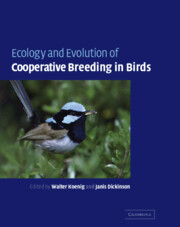Book contents
- Frontmatter
- Contents
- List of contributors
- Introduction
- 1 Evolutionary origins
- 2 Delayed dispersal
- 3 Fitness consequences of helping
- 4 Parental care, load-lightening, and costs
- 5 Mating systems and sexual conflict
- 6 Sex-ratio manipulation
- 7 Physiological ecology
- 8 Endocrinology
- 9 Incest and incest avoidance
- 10 Reproductive skew
- 11 Joint laying systems
- 12 Conservation biology
- 13 Mammals: comparisons and contrasts
- 14 Summary
- Names of bird and mammal species mentioned in the text
- References
- Taxonomic index
- Subject index
7 - Physiological ecology
Published online by Cambridge University Press: 02 December 2009
- Frontmatter
- Contents
- List of contributors
- Introduction
- 1 Evolutionary origins
- 2 Delayed dispersal
- 3 Fitness consequences of helping
- 4 Parental care, load-lightening, and costs
- 5 Mating systems and sexual conflict
- 6 Sex-ratio manipulation
- 7 Physiological ecology
- 8 Endocrinology
- 9 Incest and incest avoidance
- 10 Reproductive skew
- 11 Joint laying systems
- 12 Conservation biology
- 13 Mammals: comparisons and contrasts
- 14 Summary
- Names of bird and mammal species mentioned in the text
- References
- Taxonomic index
- Subject index
Summary
Despite elegant work by Reyer and his colleagues on the proximate endocrinological and physiological mechanisms of cooperative breeding (Reyer and Westerterp 1985; Reyer et al. 1986), no more than peripheral mention of such factors was made in Brown's (1987) comprehensive review of cooperative breeding. Indeed, most research on cooperatively breeding birds has until recently focused on its functional consequences rather than the mechanisms that underpin it. However, evolutionary and mechanistic approaches complement each other and much can be learned by considering both (Sherman 1988; Mumme 1997; Creel and Waser 1997).
This situation contrasts from that of mammals, where physiological and other proximate causes of cooperative breeding have featured prominently (Solomon and French 1997). The degree to which this is beginning to change is highlighted here and in the following chapter.
Here I provide a general review of the physiological mechanisms and behaviors used by cooperatively breeding birds to survive and reproduce in their environment. As a simplifying framework, I consider the breeding and non-breeding periods separately. These equate roughly to the heuristic dichotomy of, first, factors that determine why cooperative breeders live in groups and, second, why non-breeders help during the breeding season (“group-living” versus “alloparental” effects as defined by Koenig and Mumme 1990).
PHYSIOLOGICAL FACTORS: THE NON-BREEDING SEASON
Food and foraging
Diet
Different workers have made conflicting predictions about the nature of constraints on cooperative breeding.
- Type
- Chapter
- Information
- Ecology and Evolution of Cooperative Breeding in Birds , pp. 117 - 127Publisher: Cambridge University PressPrint publication year: 2004
- 12
- Cited by



